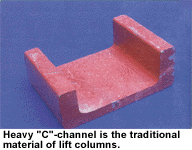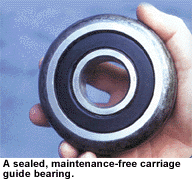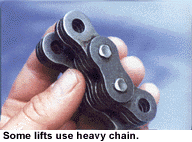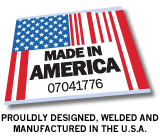Reprinted with permission of MotorService Magazine, August 2000
We help you make that big purchasing decision
You’re not sure which one you’re going to buy yet but you are sure of one thing: Everyone you talk to says his lift is the best! After a while, it’s hard to know what the truth is even when it’s staring you in the face. Sometimes you even end up being more confused than when you started. This article is about cutting through all the noise and seeing the nuts and bolts of the issue: Which design is most versatile? Which company is going to be there to support you after the money is spent? Which lift is going to provide the best long-term investment?
There are many ways to sift through all the available products and determine what is the best lfit for the type of business you have. Many manufacturers make good lifts. The best of those manufacturers will share common features. Ask your potential supplier several key questions about each of the following items, and it will become obvious who has substance and who has the smoke and mirrors.
For starters, let’s narrow our discussion down to the twin-post above-ground lift, the most popular lift bought today. While other designs might be a better fit for your exact type of shop, the two-post above-ground represents about three quarters of today’s lift market. By demanding the following features and asking the following tough questions, the decision about which lift to buy should become easier.
There are many ways to build a two-post lift. Each component may vary a great deal from one manufacturer to another. Let’s look at a few of the major components more carefully.
 Columns
Columns
There are three or four ways to build a column. The first and oldest way uses a very heavy “C” channel. This rigid design is very similar in construction to a fork lift. While most above-gound lifts start out using this gauge, most companies have switched to lighter materials in order to lower costs in a price-competitive market. The next common design is a folded sheet metal column. The thickness of the sheet metal and the number bends in each column determine the column’s strength. While this design works well enough, when relatively thin steel is used, it flexes a lot under a heavy load. The less flexing a lift does, the more forgiving it will be when your technicians are pushing and pulling against a transmission or a stubborn ball joint. Other designs include “I” beam columns, and a few lifts use a folded sheet metal box with square tubing welded inside for added strength. Of the four designs, the “C” channel is the most rugged, and, if the fork lift industry is any indicator, it’s the one likely to be around the longest.
Carriages
Carriages are the parts that move up and down inside the column. Welded from thick plates or folded sheet metal, the carriage design has two points worth asking about: What guides the carriage within the column, and how is the arm held in place?
Take note of the safety system. Is the safety in the column or part of the carriage? In most cases where the safeties are part of the column, they don’t function below tow or three feet. To be safe under a lift while it’s at or near the ground (while servicing brakes or struts, for example), be sure to ask if the safeties are active at all heights.
 Carriage Guides
Carriage Guides
As the lift goes up, carriage guides go between the steel of the carriage and the steel of the column to keep them from wearing each other out. A bearing, a roller, or a plastic slide are used in the different designs. The bearing is a sealed, hardened, tight-fitting part, which requires no maintenance. The bearings fit snugly and the carriage cannot tilt in the column. The best bearings are packed with grease and double sealed to keep out the debris found in most automotive shops.
The next best thing to a bearing is a roller. While the roller is stronger than a plastic slide and fits tighter to eliminate slop, it usually incorporates some type of sacrificial material to bear the brunt of the wear. A roller in a heavy-duty application like a lift will wear out the bronze bushing on which it rolls. Left unserviced, the problem can result in a chain or cable failure. Any lift with a pulley or a roller can experience this kind of wear and most will need replacement during their service life.
 Finally, there are plastic slides. These slides are the least expensive way to build the carriage but are the most demanding in terms of maintenance. The plastic material used in these slides, UHMW, is very hard and can withstand a great deal of pressure. But since these slides do not actually turn as the carriage rises, they require more play in the carriage to prevent binding. This play may make the carriage tilt unevenly as it rises. Also, they require regular attention. While slide block lifts are always cheaper than bearing lifts, most manufacturers require that the columns be degreased, cleaned, and re-lubricated monthly. In reality, most shop owners are too busy to do this regularly and the slides wear out prematurely. If this happens, be prepared to pay a hefty service bill since the lift will need to be completely torn down to remove the carriages and replace the sliders. Be aware that some companies call their sliders “bearings.” Ask what they mean to be sure.
Finally, there are plastic slides. These slides are the least expensive way to build the carriage but are the most demanding in terms of maintenance. The plastic material used in these slides, UHMW, is very hard and can withstand a great deal of pressure. But since these slides do not actually turn as the carriage rises, they require more play in the carriage to prevent binding. This play may make the carriage tilt unevenly as it rises. Also, they require regular attention. While slide block lifts are always cheaper than bearing lifts, most manufacturers require that the columns be degreased, cleaned, and re-lubricated monthly. In reality, most shop owners are too busy to do this regularly and the slides wear out prematurely. If this happens, be prepared to pay a hefty service bill since the lift will need to be completely torn down to remove the carriages and replace the sliders. Be aware that some companies call their sliders “bearings.” Ask what they mean to be sure.
 Arms
Arms
For long-term non-dropping performance, look for a lift with arms that are supported from underneath. The strongest carriage designs use a steel plate on the top and the bottom that sandwiches the lifting arm. Alternatively, some companies support their lifting arms by drilling a hole through two plates and pinning the arm to the carriage. While this technique does work and saves money, it places all of the vehicle’s weight against the pin. Over time, these pins and the holes they go through become worn. As a result of these egg-shaped holes, the arms drag on the floor, and you’ll eventually need to replace the arms, pins, and carriages.
 Chains, Cables or Nothing
Chains, Cables or Nothing
Ask what keeps the lift level. What pushes (or pulls) the car up? The majority of lists use a piston to do the heavy lifting. But what else do they use? Are they lifting with chains or cables? Are they maintaining level by these devices? With pulleys?
The answers to these questions will tell you a lot about how high your maintenance costs will be later on. Lifting and leveling are two different things. Ask how big the piston is (some companies use only one piston, but most use two). Some lift companies use a piston as small as 1-1/8 in., while others have pistons 3-5/8 in diameter. The greater the piston’s diameter, the easier the work will be and the longer the pump/seals/hoses will last.
 Chain, as opposed to cable, is likely to last much longer on a lift. Even when cables are used for leveling, they still bear a heavy load when a safety engages or if the vehicle is loaded off-center. Ask to look at an installation manual and you will likely see a monthly maintenance requirement. Cables in lifts are vulnerable to road salt, rust, and grit. Like clutch cables, they eventually run out of adjustment and need replacement. The bigger issue however, is the cost of downtime. A set of cables may only cost you $300-$400, but what will it cost if one breaks while the car is still on the lift? What do you think the chances are that it will break when the lift is empty? And, finally, what if it takes two days to air-freight the parts? How much repair work will you lose while waiting?
Chain, as opposed to cable, is likely to last much longer on a lift. Even when cables are used for leveling, they still bear a heavy load when a safety engages or if the vehicle is loaded off-center. Ask to look at an installation manual and you will likely see a monthly maintenance requirement. Cables in lifts are vulnerable to road salt, rust, and grit. Like clutch cables, they eventually run out of adjustment and need replacement. The bigger issue however, is the cost of downtime. A set of cables may only cost you $300-$400, but what will it cost if one breaks while the car is still on the lift? What do you think the chances are that it will break when the lift is empty? And, finally, what if it takes two days to air-freight the parts? How much repair work will you lose while waiting?
Cleary, when it comes to lifts, the lower the price, the more likely you are to experience higher maintenance expenses. Chains are rarley going to need to be replaced but cables probably will. If you buy a lift with cables, be committed to taking good care of it.
There are a few other design questions to ask. Does the lift use hoses or stainless steel line? Are truck adaptoers standard or optional? How many sets come with each lift?
What kind of company am I dealing with?
After considering those major items, the next key to a smart lift purchase revolves around knowing who your manufacturer is.
The first and best indicator of who your supplier is and how likely it is to stand behind its product later is its commitment to safety. The newest ANSI standard for lift safety (A.N.S.I./ALCTV-98) was developed by ETL, an OSHA-recognized testing laboratory. The program, developed by participating members of the Automotive Lift Institute (ALI), requires that lift manufacturers that wish to label their products as “certified” must subject their lifts to rigorous testing and must put in place stringent quality control procedures. The ALI is responsible for such recent advances in product safety as arm restraints, chain break safeties and hydraulic blow-out valves. Look for the “ETL certified” label.
Another way to judge your manufacturer’s commitment to your success is the warranty. More than any other issue, on his one YOU HAVE TO DO YOUR HOMEWORK! For example, a company says it has a five-year warranty, but does that cover parts, labor, travel and shipping charges? Labor alone can cost $500.
For some companies, warranty work is actually a profit center. A lift manufacturer may be willing to offer a low purchase price to get you to buy, but once you become a customer, you’re locked into that company for parts. Unfortunately, sometimes those parts cost more than they should. Keep in mind that a service call to fix a leaky piston, worn rollers, or broken cables can easily run $1000.
Be a smart consumer and call the factory for warranty details because reps, tool salesmen, and distributors can sometimes be confused on this issue. Ask for a copy of the warranty in writing. In most cases, the warranty only covers defects in workmanship. Even then, it may be up to you to prove that a part was defective by shipping it cross-country at your expense. Worse still, your lift will be out of service while you wait for the replacement.
One way to be sure you’re doing business with the right company is to ask how warranty parts are sent out. Find a company that ships parts freight prepaid. Find a company that will pay for travel for a service call, or ship a swap-out cylinder so you don’t have to take a lift off-line. Remember, a cheap tool always costs more than a good one.
In buying your next lift ask the important questions. Be sure to buy the best value instead of the best price.



 Columns
Columns Carriage Guides
Carriage Guides Finally, there are plastic slides. These slides are the least expensive way to build the carriage but are the most demanding in terms of maintenance. The plastic material used in these slides, UHMW, is very hard and can withstand a great deal of pressure. But since these slides do not actually turn as the carriage rises, they require more play in the carriage to prevent binding. This play may make the carriage tilt unevenly as it rises. Also, they require regular attention. While slide block lifts are always cheaper than bearing lifts, most manufacturers require that the columns be degreased, cleaned, and re-lubricated monthly. In reality, most shop owners are too busy to do this regularly and the slides wear out prematurely. If this happens, be prepared to pay a hefty service bill since the lift will need to be completely torn down to remove the carriages and replace the sliders. Be aware that some companies call their sliders “bearings.” Ask what they mean to be sure.
Finally, there are plastic slides. These slides are the least expensive way to build the carriage but are the most demanding in terms of maintenance. The plastic material used in these slides, UHMW, is very hard and can withstand a great deal of pressure. But since these slides do not actually turn as the carriage rises, they require more play in the carriage to prevent binding. This play may make the carriage tilt unevenly as it rises. Also, they require regular attention. While slide block lifts are always cheaper than bearing lifts, most manufacturers require that the columns be degreased, cleaned, and re-lubricated monthly. In reality, most shop owners are too busy to do this regularly and the slides wear out prematurely. If this happens, be prepared to pay a hefty service bill since the lift will need to be completely torn down to remove the carriages and replace the sliders. Be aware that some companies call their sliders “bearings.” Ask what they mean to be sure. Arms
Arms Chains, Cables or Nothing
Chains, Cables or Nothing Chain, as opposed to cable, is likely to last much longer on a lift. Even when cables are used for leveling, they still bear a heavy load when a safety engages or if the vehicle is loaded off-center. Ask to look at an installation manual and you will likely see a monthly maintenance requirement. Cables in lifts are vulnerable to road salt, rust, and grit. Like clutch cables, they eventually run out of adjustment and need replacement. The bigger issue however, is the cost of downtime. A set of cables may only cost you $300-$400, but what will it cost if one breaks while the car is still on the lift? What do you think the chances are that it will break when the lift is empty? And, finally, what if it takes two days to air-freight the parts? How much repair work will you lose while waiting?
Chain, as opposed to cable, is likely to last much longer on a lift. Even when cables are used for leveling, they still bear a heavy load when a safety engages or if the vehicle is loaded off-center. Ask to look at an installation manual and you will likely see a monthly maintenance requirement. Cables in lifts are vulnerable to road salt, rust, and grit. Like clutch cables, they eventually run out of adjustment and need replacement. The bigger issue however, is the cost of downtime. A set of cables may only cost you $300-$400, but what will it cost if one breaks while the car is still on the lift? What do you think the chances are that it will break when the lift is empty? And, finally, what if it takes two days to air-freight the parts? How much repair work will you lose while waiting?
 Lift certification: What is it? What does a certified lift mean to you, as the purchaser? In basic terms, a certified product is a product that has had a representative specimen tested, and is under continued follow-up inspections by a Nationally Recognized Testing Laboratory, as defined by the Occupational Safety and Health Administration…
Lift certification: What is it? What does a certified lift mean to you, as the purchaser? In basic terms, a certified product is a product that has had a representative specimen tested, and is under continued follow-up inspections by a Nationally Recognized Testing Laboratory, as defined by the Occupational Safety and Health Administration… How Public Sector fleets can save money, procurement time and stretch budgets.
How Public Sector fleets can save money, procurement time and stretch budgets. By: Steve Perlstein
By: Steve Perlstein
 Andy Cohen producer of THE ROAD TO SEMA uses Mohawk lifts in the fabrication & customization of all vehicles in his shop.
Andy Cohen producer of THE ROAD TO SEMA uses Mohawk lifts in the fabrication & customization of all vehicles in his shop.
 by: statepolitics.lohudblogs.com
by: statepolitics.lohudblogs.com